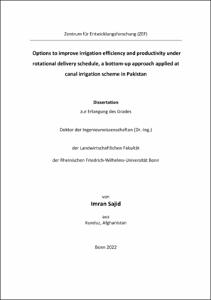Small-Scale Irrigation in the Sahel: Adoption Trends, Profitability, and Challenges

Small-Scale Irrigation in the Sahel: Adoption Trends, Profitability, and Challenges

| dc.contributor.author | Faye, Amy | |
| dc.contributor.author | von Braun, Joachim | |
| dc.date.accessioned | 2024-11-28T15:29:58Z | |
| dc.date.available | 2024-11-28T15:29:58Z | |
| dc.date.issued | 26.11.2024 | |
| dc.identifier.uri | https://hdl.handle.net/20.500.11811/12584 | |
| dc.description.abstract | This paper analyzes the current uptake of small-scale irrigation (SSI1), its profitability, and the constraints to its broader adoption in the Sahel using literature and survey data from Burkina Faso, Mali, Niger, and Senegal. Unlike most of the literature on irrigation in Sub-Saharan Africa (SSA), this analysis distinguishes unambiguously between farmer-led SSI (FSSI) and nonfarmer- led SSI (NFSSI) and analyzes labour profitability of SSI. Inverse probability weighing techniques are used to balance covariates between SSIs and non-SSIs and between FSSIs and non-FSSIs. The results show very low SSI adoption rates in the Sahel region. With the highest rates, Mali outperforms its neighbours, despite its political instability. However, FSSI is more common than NFSSI in Niger and Burkina Faso and less common in Mali and Senegal. Profitability analysis at the plot level shows that SSI is a more profitable land use activity compared to rainfed cropping. However, the two approaches complement each other as SSI mainly occurs during the dry season in the Sahel. On the other hand, FSSI is more profitable than NFSSI except in Mali where NFSSI has historically been a pathway to irrigation development through public irrigation schemes aiming for rice cultivation. Yet, FSSI generally has higher variable costs which could be reduced by promoting solar-powered technologies that could lead to irrigation expansion, especially for individual FSSI, provided that financial mechanisms are developed to enable the required initial investments. Results further show that for SSIs, irrigated high value crops such as vegetables are more profitable and require less land than the traditionally promoted rice in these Sahelian countries. Finally, the comparison of SSIs and non-SSIs and of FSSIs and NFSSIs shows that investments in irrigation development and adoption should account for the specificities of SSIs compared to non-irrigators and larger scale irrigators as well as the heterogeneity of SSIs that can be farmer-led or not. | en |
| dc.format.extent | 82 | |
| dc.language.iso | eng | |
| dc.relation.ispartofseries | ZEF – Discussion Papers on Development Policy ; 353 | |
| dc.rights | Attribution-NonCommercial-NoDerivatives 4.0 International | |
| dc.rights.uri | http://creativecommons.org/licenses/by-nc-nd/4.0/ | |
| dc.subject | Sahel | |
| dc.subject | Irrigation | |
| dc.subject | Small-scale irrigation | |
| dc.subject | Farmer-led irrigation | |
| dc.subject | Irrigation technology | |
| dc.subject | Profitability | |
| dc.subject | Labour productivity | |
| dc.subject.ddc | 300 Sozialwissenschaften, Soziologie, Anthropologie | |
| dc.title | Small-Scale Irrigation in the Sahel: Adoption Trends, Profitability, and Challenges | |
| dc.type | Arbeitspapier | |
| dc.identifier.doi | https://doi.org/10.48565/bonndoc-432 | |
| dc.publisher.name | Center for Development Research (ZEF), University of Bonn | |
| dc.publisher.location | Bonn | |
| dc.rights.accessRights | openAccess | |
| ulbbn.pubtype | Erstveröffentlichung |







